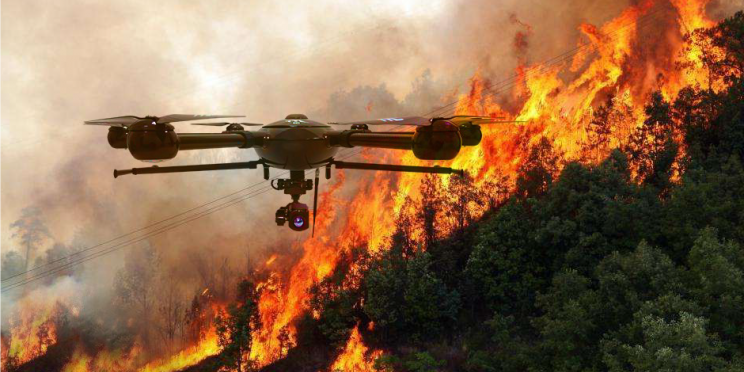Firedrone to improve safety of firefighters’ response to industrial fires
14/10/2021

A compact airborne robotic drone for live monitoring dangerous emissions in smoke is being developed by cross-border project Firedrone, to improve responses to large and complex industrial fires and wildfires.
The R&D project, which is funded by the EU’s Interreg France (Channel) England programme, is led by INSA Rouen Normandie and being delivered with 5 project partners: University of Southampton, Université de Rouen Normandie, air quality monitoring organisation AtmoNormandie and drone operators; Consortiq and Surrey Search and Rescue. They will work in close cooperation with experts in drone operations and end-users, such as fire brigades and training centres.
Together the team will develop a new robotic drone to improve the speed, accuracy, and safety of firefighters’ response to industrial fires, such as Lubrizol factory fire in Rouen in September 2019, which demonstrated the need to develop such a technology.
Marek Mazur, project coordinator, INSA Rouen Normandie, said: “There is a pressing need for technological solutions given that large scale industrial fires are happening repeatedly. For example, there was the Piper Alpha fire in 1988 and Buncefield fire in 2005. We are also seeing recurring wildfires every summer in Europe and across the world.”
Industrial fires and wildfires are a risk within the Channel area given that it has a population of around 27.5 million and a large industrial sector, where dangerous substances may be used or stored in large quantities.
In total, there are 289 industrial sites in France and 150 industrial sites in the UK which are part of the Channel region and have been identified as potentially dangerous for the population and environment in case of a major accident. This is due to the use of dangerous chemicals, which is unavoidable and vital in a modern industrialised society.
Marek Mazur, project coordinator, INSA Rouen Normandie, added: “Currently, firefighters and first responders typically rely on sensors to capture information about black carbon nanoparticles, which are formed during the incomplete combustion of hydrocarbons during industrial fires. For robust analysis of the impact of black carbon, there needs to be in-situ data collected in real-time. However, unsurprisingly, this is hard to do during a large-scale fire.”
“Current approaches are not affordable, user-friendly, and standardized enough to be accessible to the first-responder community. And most sampling methods require someone to go into a hazardous environment, limiting collection to human height sampling only.”
Firedrone will address this challenge by developing a robust, easy to handle drone capable of operating in smoke plumes. The project team will also design operational procedures and provide demonstrations to emergency services, to support uptake of this new innovative technology and ensure the safest and most effective procedures are adopted by emergency services when using the system in a fire accident.
The novel device will analyse particles in fire smoke 90% faster and 80% cheaper than current equivalent solutions while providing more accurate data. The project results will be published in scientific publications and available open access to support the fast commercialisation of this technology and ensure other regions and countries can benefit.
Firedrone project has a total budget of €1,7m, of which €1,2 has been co-financed by the European Regional Development Fund via the Interreg France (Channel) England programme.
More information:
Project website: https://www.coria.fr/projets/firedrone/
Project summary: Fire/Fast incident response equipment for the description of noxious particle emissions | Interreg (channelmanche.com)
